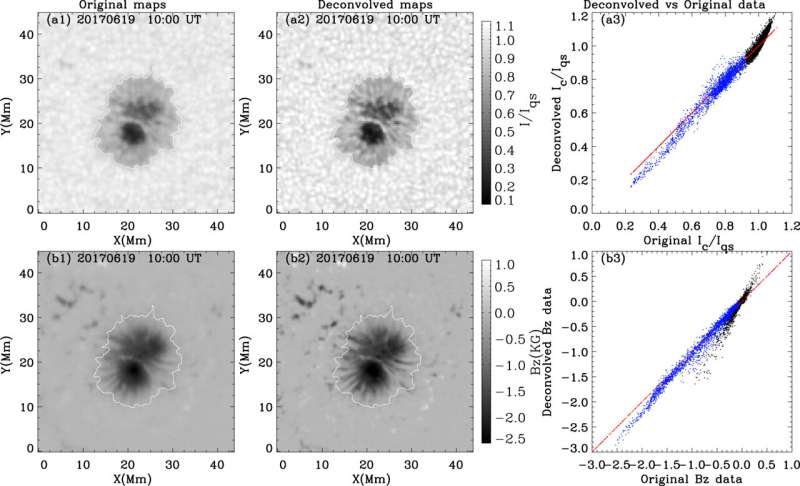Researchers determine bright-magnetic relationship for decaying sunspots

Prof. Yan Xiaoli from Yunnan Observatories of the Chinese Academy of Sciences and Li Qiaoling, a post-doctor from Yunnan University, have determined the bright-magnetic relationship for decaying sunspots for the first time.
Related results were published in The Astrophysical Journal.
The brightness of sunspots is an important parameter in the study of the total irradiance of the sun and a key index to verify the dynamics and magnetic properties of sunspots. The relationship between sunspot brightness and its magnetic field strength is known as the bright-magnetic relationship.
The study of the bright-magnetic relationship of sunspots is helpful to understand the brightness and atmospheric structure of sunspots, and provides constraints for the theoretical model of the energy transport mechanism of sunspots.
Previous observational studies on the bright-magnetic relationship of sunspots have mostly focused on stable sunspots, and few have studied the bright-magnetic relationship of decaying sunspots.
The researchers analyzed the difference of the bright-magnetic relationship between the stable and decaying sunspots by using the stray light calibration data from the Solar Dynamics Observatory Helioseismic and Magnetic Imaging.
They found that the difference of the bright-magnetic relationship between stable and decaying sunspots was mainly manifested in the continuum intensity (brightness) range from 0.35 Iqs to 0.65 Iqs (Iqs is the average continuum intensity of the quiet sun). In the decaying sunspot, the relationship between the continuum intensity and the transverse magnetic field strength showed a higher degree of dispersion.
"We also found a bifurcation structure in the relationship between the continuum intensity and the transverse magnetic field strength during the formation of the light bridge. This bifurcation structure indicates that the two parts of the umbra separated by the light bridge have different thermodynamic properties," said Prof. Yan.
"The continuum intensity of the sunspot umbra in decaying sunspots is brighter than that of a stable sunspot, and the mean continuum intensity of the sunspot umbra gradually increases during the decay of sunspot. However, the mean continuum intensity of the penumbra does not change with the decay of the sunspot," said Li.
These results indicate that during the decay of sunspot, the temperature of the umbra increases gradually, but the temperature of the penumbra remains constant.
More information: Qiaoling Li et al, Dependence of the Continuum Intensities on the Magnetic Fields at Different Evolution Phases of Sunspots, The Astrophysical Journal (2022).
Journal information: Astrophysical Journal
Provided by Chinese Academy of Sciences




















